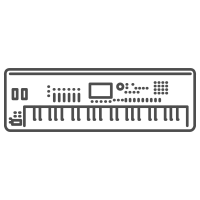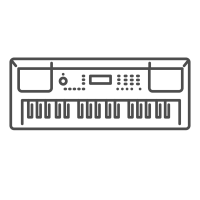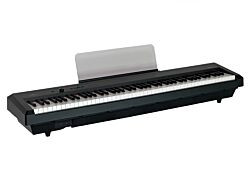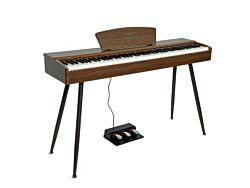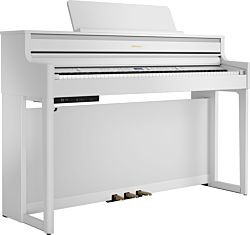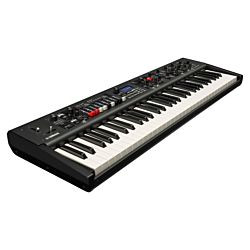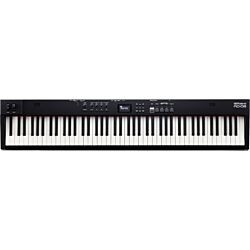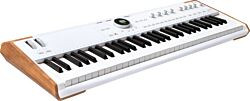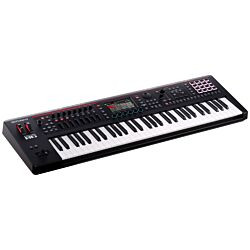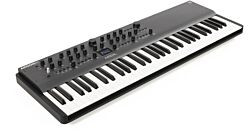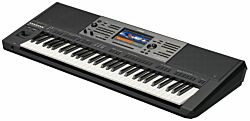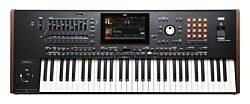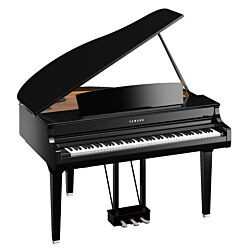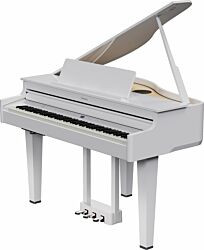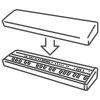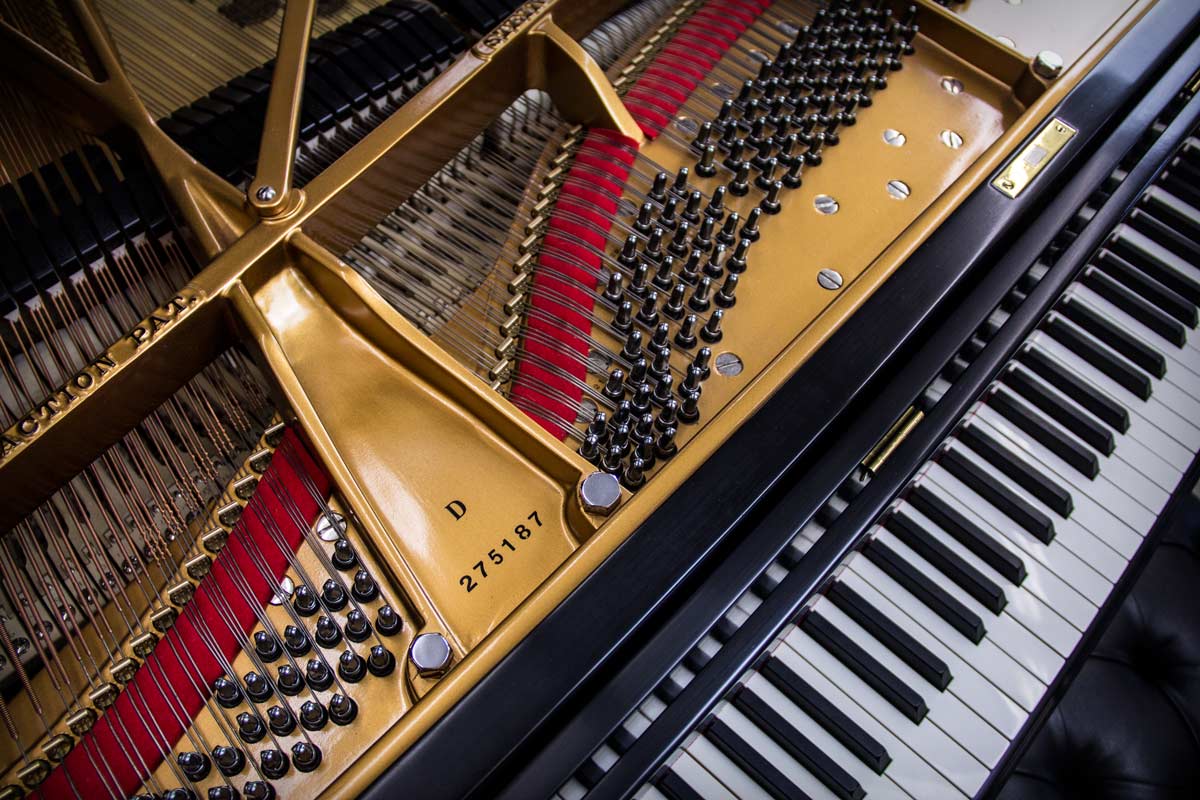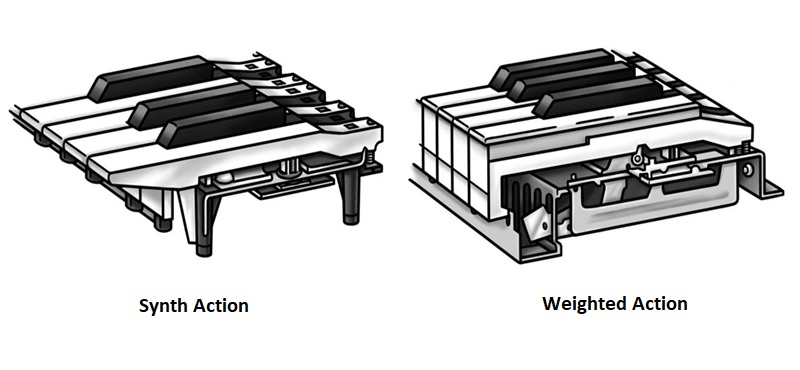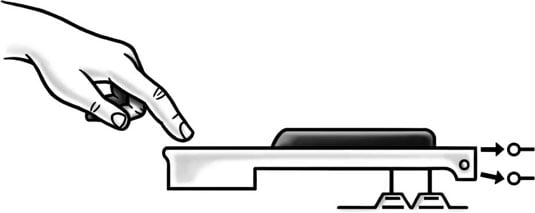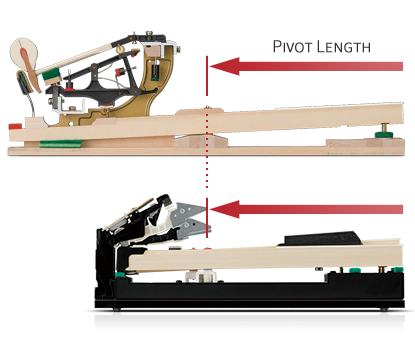Guide to key action
There are tons of different key actions, depending on the brand, series and price range. There is no “one right way” to build a keyboard, but some attributes make the digital keys more akin to the keys of an acoustic instrument.
Weighted keys:
The keys of A synthesizer or a keyboard are usually not weighted or only semi-weighted. They use a “spring” mechanism. If you want to improve your finger technique, then you will need fully weighted keys, like the ones you would find on an acoustic piano. Most digital pianos also have fully weighted keys that imitate the feeling and touch of an acoustic piano.
On an acoustic instrument, you will find that the strings are increasingly thicker towards the bass end of the piano, while the strings are thinner for the treble keys. The thicker the strings, the harder it is to press down the key. This property has been imitated in many digital pianos to make the feeling of the keys as realistic as possible. Some pianos are weighted in sections (octaves) that gradually get heavier while the most authentic have individually weighted keys. The latter results in a more precise and sophisticated feel of the keys.
Length:
The length of the keys is closely connected with the authenticity. In the acoustic piano, you only see a small part of the actual key; the rest lies hidden inside the piano. When playing more advanced pieces, you sometimes need to play further back on the keys, to be able to reach all the notes. If the “hidden” part of the key is short, the pressing down of the key (on the back of the key) can feel resistant and heavy. But if the “hidden” part is longer, then the pivot point is moved further back on the key. Thus, the force requred to depress each key is more consistent throughout its length and you can play with more precision and control.
Sensors:
When you press down a key on an acoustic or grand piano, you activate a small hammer which strikes the string inside the piano. This is not the case with digital pianos, since they have no strings, but instead digital “sampling” or “modeling”. When you press down a key on a digital piano, it is registered by one or more sensors that detect how hard or softly you play. The number and quality of the sensors determines how nuanced and dynamically you can play the instrument.
Escapement/ let-off mechanism:
Grand pianos have a mechanism called Escapement. This mechanism moves the hammers from the strings right after striking them, so that they do not disturb the vibrations of the strings, which create the tone. When the hammer moves away it results in a slight “clicking” feeling when you play softly or slowly on the piano. In many digital pianos, this mechanism has been recreated to create a realistic and authentic touch.
Dynamic range:
A fundamental part of music is dynamics. You can play piano pianissimo or forte fortissimo and anything in between. In digital pianos the dynamic levels are divided into velocity levels. Usually, you will find a wide range of different velocity levels, from quiet to loud. Expensive pianos often have many more levels and registers, which allow the pianist to play with great sensitivity.
Surface:
On many older pianos you will find the surface of the key being made of ivory from the tusk of elephants, and sometimes ebony for the black keys. Ivory feels dry and matte and helps you not to slip on the keys when playing rapidly. In the 1980’s, it became illegal to use ivory on keys, because of the protection of endangered species. Subsequently, manufacors started to produce keys with synthetic ivory and ebony surfaces with the same dry feeling to imitate the feeling of the older pianos.
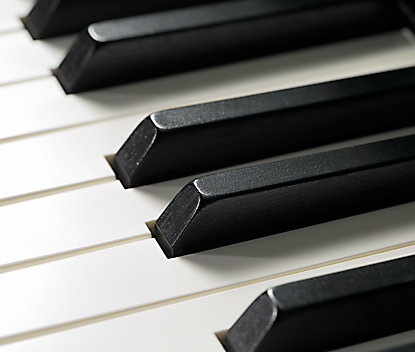
Yamaha
Graded Hammer Standard (GHS)
- Graded, weighted key-sections
- Double sensors
- Plastic
- Light and portable
Ex: YDP-145

Graded Hammer 3 (GH3)
- Graded, weighted key-sections
- Triple sensors
- Plastic
- Synthetic Ivory surface
Ex: YDP-165
Natural Wood X (NWX)
- Graded, weighted key-sections
- Triple sensors
- Synthetic Ivory surface
- Solid wood
- Escapement
- Heavy keys
Ex: P-515

Grand Touch-S (GT-S) af plastik
- Graded, weighted key-sections
- Triple sensors
- Synthetic ivory/ebony surface
- Plastic
- Escapement
Ex: CLP-725
Grand Touch-S (GT-S) af træ
- Graded, weighted key-sections
- Triple sensors
- Synthetic ivory/ebony surface
- Solid wood
- Escapement
Ex: CLP-745
Grand Touch (GT)
- Individually weighted keys
- Triple sensors
- Synthetic ivory/ebony surface
- Solid wood
- Escapement
- Long keys
Ex: CLP-775
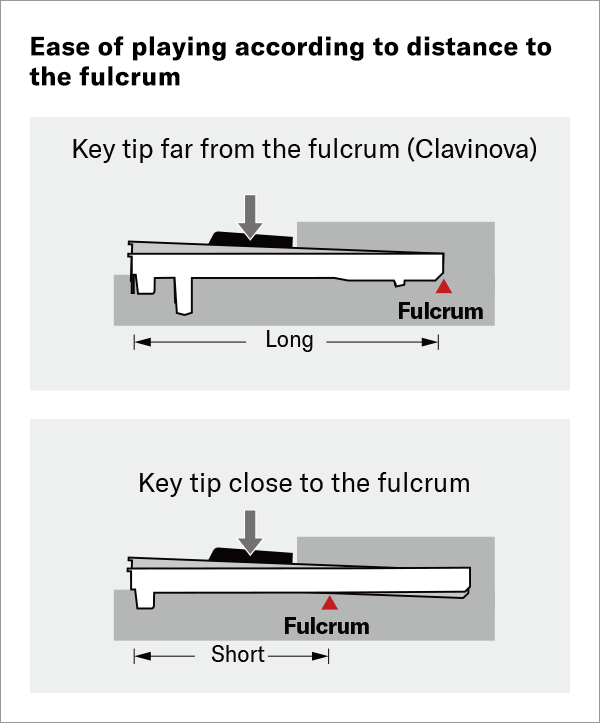
Specialized Grand Piano Action (SGP)
- Individually weighted keys
- Triple sensors
- Synthetic ivory/ebony surface
- Solid wood
- Escapement
- Long keys
- Hammers
Ex: N1X
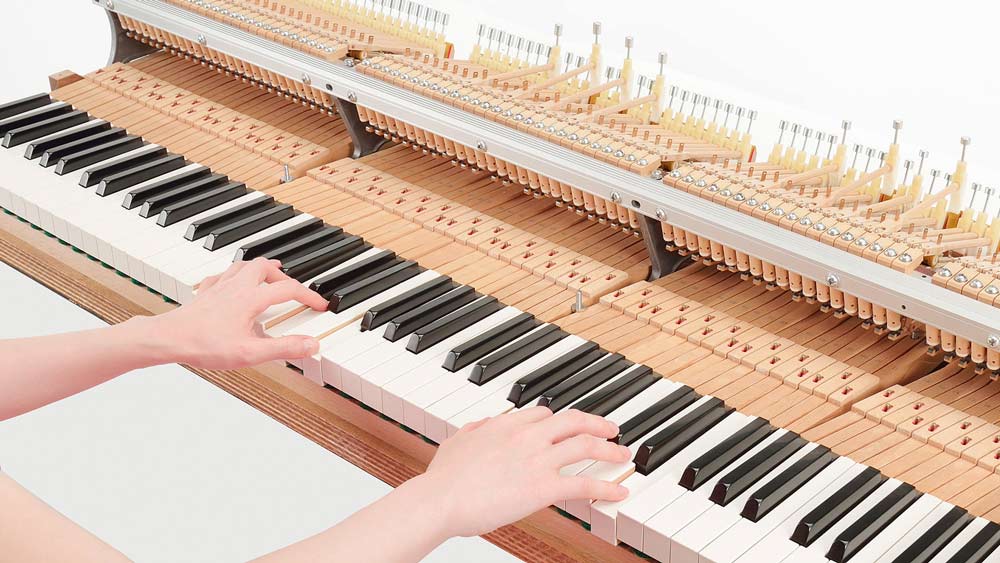
Roland
Progressive Hammer Action 4 (PHA4) Standard
- Graded, weighted key-sections
- Triple sensors
- Synthetic Ivory surface
- Plastic
- Escapement
Ex: RR-107

Progressive Hammer Action 50 (PHA-50)
- Graded, weighted key-sections
- Triple sensors
- Synthetic ivory/ebony surface
- Wood and plastic hybrid structure
- Escapement
- Acceleration sensors
Ex: HP-704

Hybrid Grand Keyboard Action (HGKA)
- Graded, weighted key-sections
- Triple sensors
- Synthetic ivory/ebony surface
- Wood and plastic hybrid structure
- Escapement
- Acceleration sensors
- Resonance vibration
- Longest key action of Roland pianos
- Stabilizing pin
Ex: LX-706
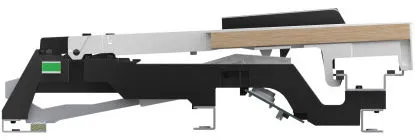
Kawai
Responsive Hammer Compact 2 (RHCII)
- Weighted keys
- Triple sensors
- Synthetic ivory surface
- Plastic
- Let-off mechanism
- Light and portable
Ex: KDP-120
Responsive Hammer 3 Action (RHIII)
- Weighted, graded keys
- Triple sensors
- Synthetic ivory surface
- Plastic
- Let-off mechanism
- Counterbalance
- Hammers
Ex: CN-201
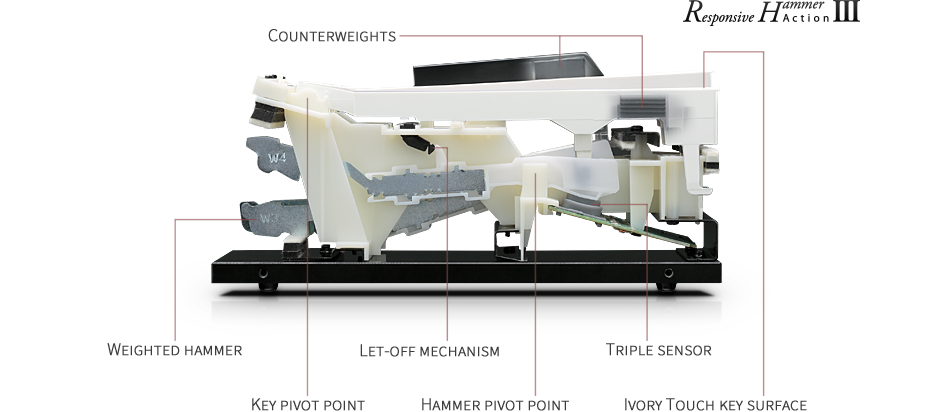
Grand Feel Compact (GFC)
- Weighted, graded keys
- Triple sensors
- Synthetic ivory surface
- Solid wood
- Let-off mechanism
- Counterbalance
- Hammers
Ex: CA-49
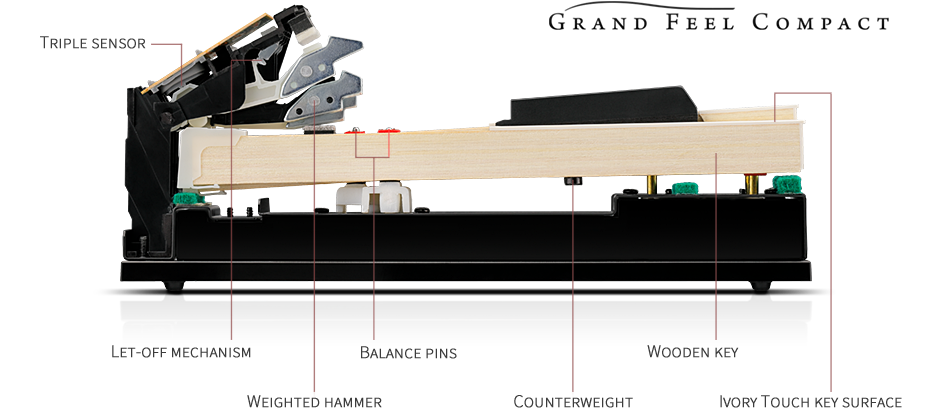
Grand Feel Action 3 (GFIII)
- Weighted, graded keys
- Triple sensors
- Synthetic ivory/ebony surface
- Solid wood
- Let-off mechanism
- Counterbalance
- Hammers
- Long keys
- Balance pins
Ex: CA-99
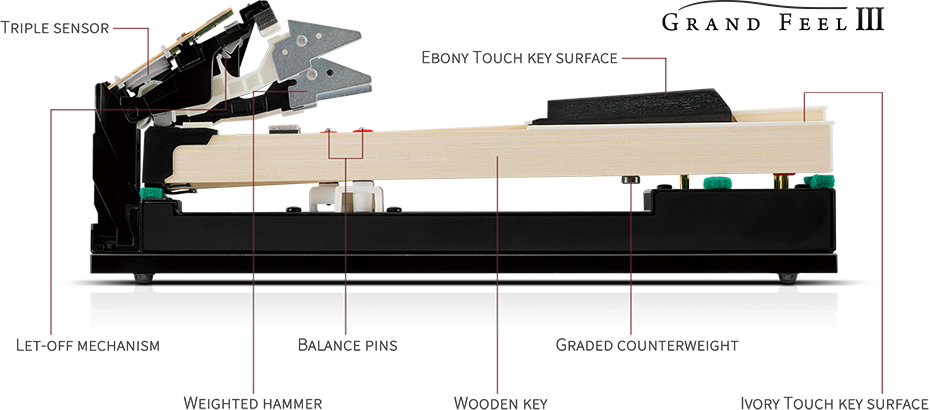
Millennium 3
- Individually weighted keys
- Triple, non-contact optical sensors
- Synthetic ivory/ebony surface
- Solid wood
- Let-off mechanism
- Damper function
- Long keys
- ABS-hammers
Ex: NV-5S



